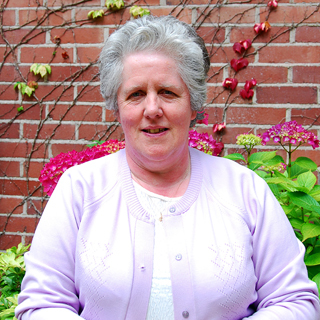Marie Crean: South Parish, Cinemas, Black and Tan’s
Title
Subject
Description
She recalls picking blackberries and slogging apples. There were few cars and everybody walked everywhere. As a child, she travelled a lot with her family on the train.
She talks about her early working life. She worked for Hanlon’s fish merchants.
Marie remembers her old neighbourhood and how some of it was demolished, both houses and shops, particularly Jackson’s Terrace.
Some men in her neighbourhood were involved in the War of Independence and the Civil War. She tells the story of the Black and Tan’s searching for them at a funeral.
Young people went courting on the disused Bandon railway line.
She worked making altar breads, with the Reparation Nuns.
She tells a funny story about how a corpse was washed and the water was thrown after the hearse afterwards.
She mentions several cinemas in Cork and recalls that The Savoy cinema had a great organist.
Date
Identifier
Coverage
Relation
CFP_SR00387_sheehan_2010; CFP_SR00388_sheehan_2010; CFP_SR00389_healy_2010; CFP_SR00390_kelleher_2010; CFP_SR00392_mckeon_2010; CFP_SR00393_twomey_2010; CFP_SR00394_stleger_2010; CFP_SR00395_speight_2010; CFP_SR00396_lane_2010; CFP_SR00397_obrienoleary_2010; CFP_SR00398_jones_2010; CFP_SR00399_saville_2010; CFP_SR00400_magnier_2010; CFP_SR00401_marshall_2010; CFP_SR00402_marshall_2010; CFP_SR00403_murphy_2010; CFP_SR00404_prout_2011; CFP_SR00405_walsh_2011; CFP_SR00406_prout_2011; CFP_SR00407_newman_2010; CFP_SR00408_newman_2010; CFP_SR00409_leahy_2011; CFP_SR00411_newman_2010; CFP_SR00412_newman_2010; CFP_SR00413_finn_2011; CFP_SR00414_ohorgain_2011; CFP_SR00415_oconnell_2011; CFP_SR00416_sheehy_2011; CFP_SR00417_mcloughlin_2012; CFP_SR00418_gerety_2012; CFP_SR00419_kelleher_2012; CFP_SR00420_byrne_2012; CFP_SR00421_cronin_2012; CFP_SR00422_ohuigin_2012; CFP_SR00423_meacle_2012; CFP_SR00424_horgan_2012; CFP_SR00425_lyons_2012; CFP_SR00427_goulding_2011;
CFP_SR00491_fitzgerald_2013.
Heritage Week 2011: CFP_SR00429_casey_2011; CFP_SR00430_tomas_2011; CFP_SR00431_newman_2011; CFP_SR00432_stillwell_2011; CFP_SR00433_oconnell_2011; CFP_SR00434_lane_2011; CFP_SR00435_montgomery-mcconville_2011; CFP_SR00436_ocallaghan_2011; CFP_SR00437_corcoran_2011; CFP_SR00438_jones_2011; CFP_SR00439_ohuigin_2011; CFP_SR00440_mccarthy_2011; CFP_SR00441_crowley_2011; CFP_SR00442_obrien_2011; CFP_SR00443_jones_2011; CFP_SR00444_mcgillicuddy_2011; CFP_SR00445_delay_2011; CFP_SR00446_murphy_2011;
Video Interview: CFP_VR00486_speight_2014
Published Material:
O’Carroll, Clíona (2011) ‘The Cork Memory Map’, Béascna 7: 184-188.
O’Carroll, Clíona (2012) ‘Cork Memory Map: an update on CFP’s Online Project’, The Archive 16: 14. https://www.ucc.ie/en/media/research/corkfolkloreproject/archivepdfs/archive16.PDF
Dee, Stephen and O’Carroll, Clíona (2012) ‘Sound Excerpts: Interviews from Heritage Week’, The Archive 16: 15-17. https://www.ucc.ie/en/media/research/corkfolkloreproject/archivepdfs/archive16.PDF
O'Carrol, Clíona (2014) 'The children's perspectives: Place-centred interviewing and multiple diversified livelihood strategies in Cork city, 1935-1960'. Béaloideas - The Journal of Folklore of Ireland Society, 82: 45-65.
The Curious Ear/Documentary on One (Cork City Memory Map) http://www.rte.ie/radio1/doconone/2011/0816/646858-curious-ear-doconone-cork-city-memory-map/
Source
Rights
Language
Type
Format
Interviewee
Interviewer
Duration
Location
Original Format
Bit Rate/Frequency
Transcription
G O’D: Thinking back to the street you grew up on, are there, are there any kind -- are there many kind of major landmarks or streets and lanes nearby, that have since been demolished or got rid of?
M C: Well, I suppose there was Jackson’s Terrace which is now gone. It was off Langford Row. That’s the one that sticks out. I remember as a child saying when I was bigger I’d cross Langford Row and go over and see the -- I thought they were spectacular houses. Sure the poor people probably didn’t think -- they were two-storey houses and a narrow kind of entrance to them and obviously like, the distance between their front doors was very little and I think there was a toilet down at the end, a communal. But they used to say it was beautifully kept, you know. The people kept the place very well. But there was -- like you couldn’t -- you’d only get a bicycle in between the, the houses but I thought it was -- you know, as a child. And I was going to cross the road and see those houses, and by the time I was ready to cross the road, Jackson’s Terrace was knocked and ‘tis the apartments there in, in -- it was a garage afterwards and then ‘tis an apartment in Langford now. And I suppose like, that whole community at the end of High Street, like there was about seven houses, like cottages in Langford Row, which was, you know, whole families. And then there was Mrs Donnelly and Curtin the bookie, and Fitzgibbon’s and Cosgrave’s and Curtin’s and Dorgan’s shop, all taken, and at the other side of the road then, there was Houston’s pub and all the houses in Summer Hill South, their gardens were shortened to make the road wide. So ‘twas a -- and then there was a whole -- there was as many more, there was about five or six houses in Summer Hill South taken as well, small houses. So ‘twas like a whole community just for progress but it was a whole community removed, you know.
G O’D: Mm, and where were they -- would they have -- where were they re-settled then?
M C: Well it -- if the people owneded the houses they just were compensated and they bought houses elsewhere, and if they didn’t they were housed in different places, mostly in Ballyphehane.

